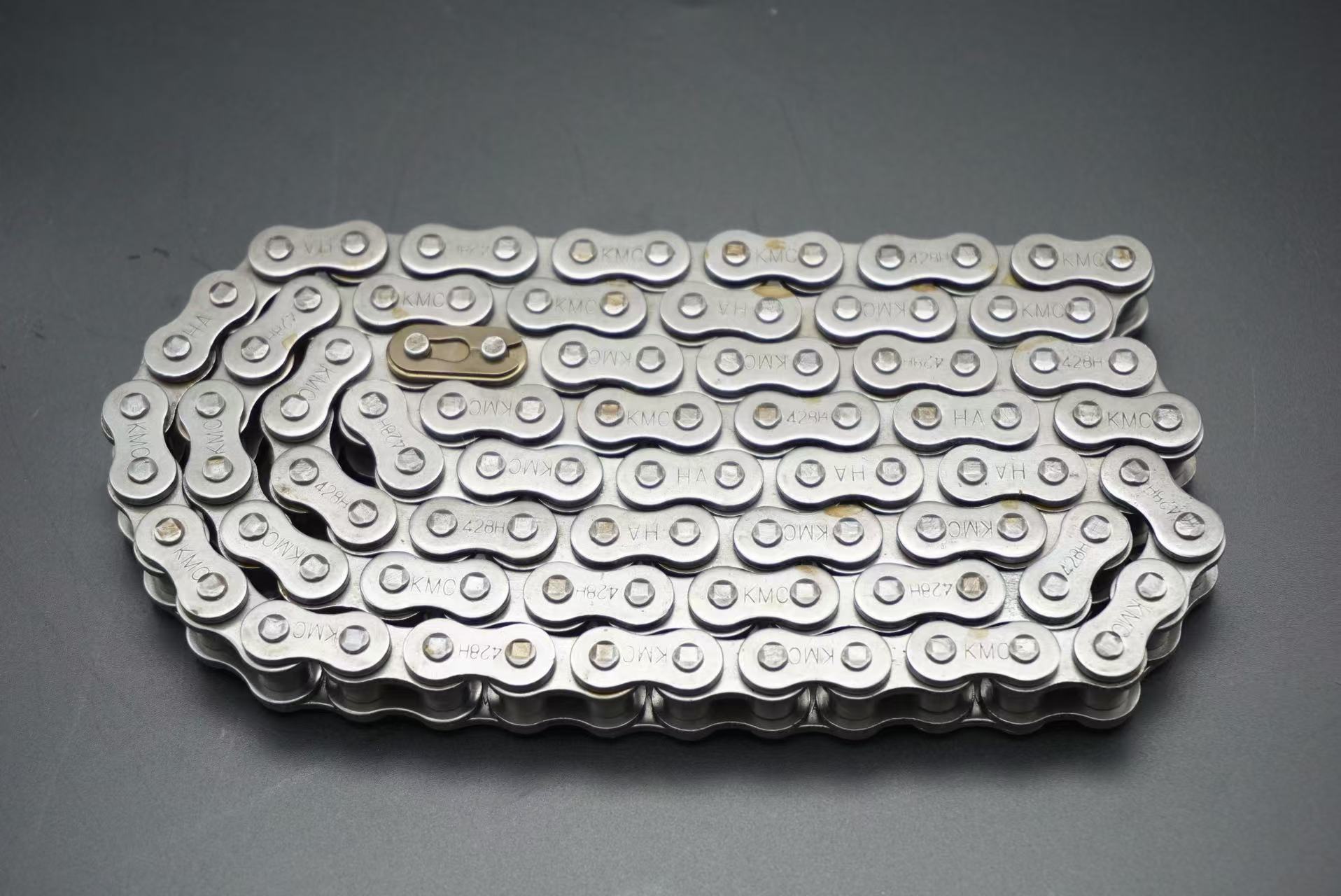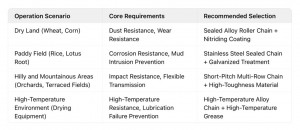Important Considerations for Agricultural Equipment Manufacturers When Selecting Roller Chains
The stable operation of agricultural equipment (tractors, combine harvesters, seeders, etc.) relies on the reliable support of its core transmission component—the roller chain. Unlike industrial settings, agricultural operations face extreme conditions such as mud, dust, alternating high and low temperatures, and heavy-load impacts. Incorrect roller chain selection can lead to equipment downtime, operational delays, and even safety hazards. As an agricultural equipment manufacturer, accurate selection is crucial to ensuring product durability and reducing customer maintenance costs. The following 7 key considerations will help you avoid selection pitfalls.
I. Material and Heat Treatment: Adaptable to Extreme Agricultural Environments
Core Requirements: Corrosion resistance, wear resistance, fatigue resistance
Prioritize high-strength alloy materials: Carburized alloy steel (such as 20CrMnTi) or stainless steel (for corrosive environments such as paddy fields and saline-alkali land) is recommended. Avoid ordinary carbon steel (prone to rust and rapid wear). **Strengthened Heat Treatment Process:** Chains must undergo carburizing, quenching, and tempering to ensure roller hardness reaches HRC 58-62 and sleeve hardness HRC 54-58, improving wear resistance and impact resistance. In high-frequency impact equipment such as combine harvesters, chains with inadequate heat treatment may have their lifespan shortened by more than 50%.
**Special Environment Adaptation:** Paddy field equipment requires galvanized or blackened chains to prevent mud and water corrosion; dryland equipment can focus on wear-resistant coatings (such as nitriding) to resist dust abrasion.
II. Specification Adaptation: Precisely Matching Equipment Power and Speed
Core Principle: “Neither too large nor too small,” perfectly matching transmission requirements.
Chain Number and Pitch Selection: Based on the equipment’s power, speed, and transmission ratio, select the chain number according to the ISO 606 international standard (e.g., commonly used A-series roller chains in agricultural machinery: 16A, 20A, 24A). Excessive chain pitch can lead to significant transmission shock, while insufficient pitch results in inadequate load-bearing capacity. For example, tractor traction mechanisms are recommended to use chains with a pitch of 25.4mm (16A) or higher, while light equipment such as seeders can use a 12.7mm (10A) pitch. Chain row design: Heavy-duty equipment (such as the threshing mechanism of a combine harvester) requires double-row or triple-row chains to improve tensile strength; light equipment (such as sprayers) can use single-row chains to reduce costs and operating resistance. Avoid “oversized selection”: Blindly choosing large-pitch, multi-row chains will increase the equipment’s weight and energy consumption, and may also lead to unstable transmission.
III. Structural Design: Focusing on Sealing and Lubrication to Reduce Maintenance Frequency
Pain Points in Agricultural Scenarios: Dust and mud easily penetrate, making lubrication difficult.
Priority: Sealed Chains: Choose sealed roller chains with O-rings or X-rings to prevent dust and mud from entering the gap between the bushing and the pin, reducing wear. Sealed chains extend the maintenance cycle by 2-3 times compared to open chains, making them especially suitable for continuous field operations.
Self-Lubricating Structure Bonus: Some high-end chains use oil-permeable or solid lubrication designs, eliminating the need for frequent manual lubrication and reducing customer operating costs (agricultural equipment often operates in remote fields where frequent lubrication is impractical).
Roller and Bushing Fit Precision: Excessive clearance allows impurities to enter, while insufficient clearance affects flexibility. It is recommended to choose products with a fit clearance ≤0.03mm to ensure smooth transmission.
IV. Mechanical Properties: Focus on Tensile Strength and Fatigue Life
Core Requirements for Agricultural Equipment: Load-bearing Capacity and Long Service Life
Tensile Strength Compliance: Based on the equipment’s maximum load, select chains with a tensile strength ≥ 1.5 times the rated load (e.g., a 20A double-row chain should have a tensile strength ≥ 132kN) to avoid breakage under heavy loads.
Fatigue Life Testing: Prioritize chains that have undergone 10⁶ cycle fatigue testing. Agricultural equipment operates for long periods daily (8-12 hours), and fatigue fracture is a common failure – a qualified chain should have a fatigue life ≥ 500 hours (continuous operation).
Impact Toughness: Field operations often encounter obstacles such as rocks and weeds; chains must possess good impact toughness (impact energy ≥ 27J) to prevent breakage from instantaneous impact.
V. Environmental Adaptability: Customized Selection for Different Operating Scenarios
Agricultural operating scenarios vary greatly, requiring selection to be tailored to local conditions.
VI. Compliance and Certification: Meets International Agricultural Equipment Standards
Avoid “Non-standard Products” and Ensure Global Market Access
Follow International Standards: Ensure chains comply with ISO 606 (international standard for roller chains), ANSI B29.1 (US standard), or DIN 8187 (German standard), avoiding non-standard products—uncertified chains may have dimensional deviations and be incompatible with mainstream international equipment components.
Industry Certification Bonus: Prioritize chains that have passed agricultural machinery industry certifications (such as EU CE certification, US AGCO certification) to enhance market acceptance of the equipment, especially suitable for export-oriented manufacturers.
Quality Traceability: Require suppliers to provide batch quality reports (material testing, mechanical performance test data) for easy subsequent product quality traceability.
VII. Installation and Maintenance Compatibility: Lowering the Barrier to Entry for Customers
Manufacturers need to balance “ease of installation” and “low maintenance costs.” Interface Design Compatibility: Chain joints should use spring clips or cotter pins for easy on-site installation and replacement (complex joints increase maintenance difficulty due to limited maintenance conditions for agricultural equipment). Lubrication Universality: Choose chains compatible with common agricultural greases to avoid reliance on specialized lubricants (customers face high costs and limited access to specialized greases). Size Compatibility: Ensure precise matching of chain and sprocket tooth profile and pitch (refer to ISO 606 sprocket standard) to avoid accelerated wear due to poor meshing.
Summary: The Core Logic of Selection – “Compatibility + Reliability”
When agricultural equipment manufacturers choose roller chains, it’s essentially a balance between “scenario compatibility + performance reliability.” There’s no need to blindly pursue “high-end materials,” but rather to comprehensively consider factors such as materials, specifications, structure, and certifications based on the equipment’s usage scenario, load characteristics, and customer maintenance needs. Choosing the right equipment not only enhances its market competitiveness but also reduces after-sales maintenance costs and builds customer trust. It is recommended to conduct small-batch installation tests (simulating 300 hours of operation in extreme field environments) before bulk purchases to verify the chain’s durability and compatibility. Select suppliers with experience in the agricultural field (such as international brands specializing in transmission components) to obtain professional technical support for selection and avoid errors caused by information asymmetry.
Post time: Nov-26-2025


